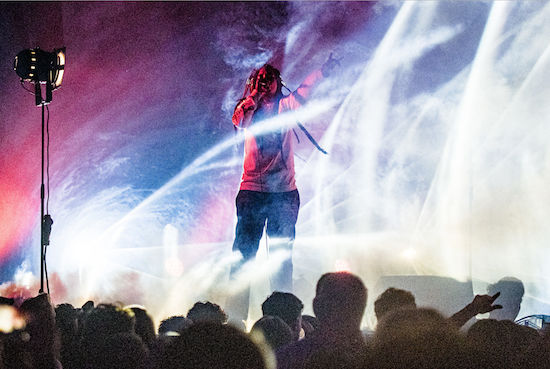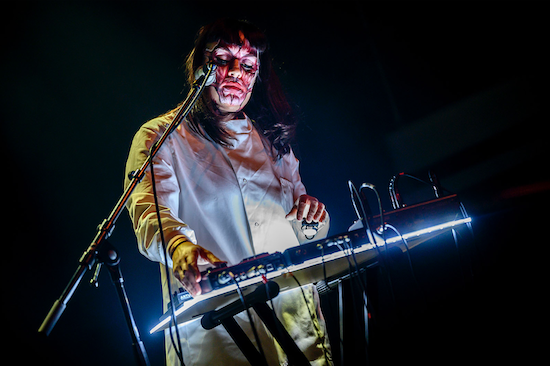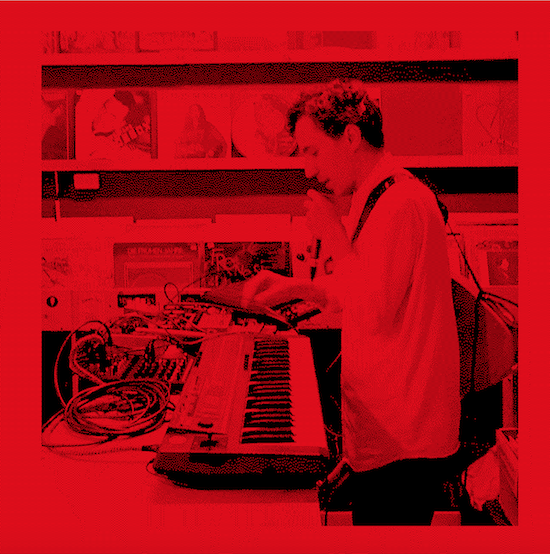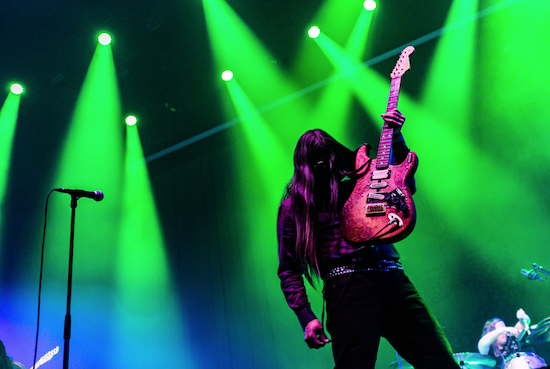Earth live photograph by Erik Luyten
On the first day of the festival, I find myself immediately drawn to the strand curated by Kevin Richard Martin aka The Bug. Godflesh, Earth and Zonal in consecutive order make opening night like an initiation rite on how to enter Martin’s universe. Earth are especially spectacular in their humility and ‘Cats On The Briar’ from their new album Full Upon Her Burning Lips is a particularly refreshing and ominous start to their set. Dylan Carlson’s repetitive guitar structures shine on drummer Adrienne Davies’ slow, incredibly held back meditative tempo bringing it all together and offering a cushioned backdrop for Carlson. Minimalist and precise, the straight riffs from ‘The Mandrake’s Hymn’ are a revelation and are an early highlight of the festival.
Martin’s musical fingerprints are all over the programme, be it on the last night together with Japanese avant garde vocalist Hatis Noit in a sonically reduced performance. With a theremin darting through the noise of Martin’s drone carpet Noit’s wailing voice reminisces Rebekah del Rio’s a capella performance of ‘Llorando’ in front of a red curtain in David Lynch’s Mulholland Drive. Or here even more spectacularly on the first night, when Martin teams up with Godflesh’s Justin Broadrick as Zonal to form a demonic supergroup together with Moor Mother and Nazamba. Playing in front of a backdrop of hellishly red stage, with a fuming dry ice machine pumping chalk clouds into the room, the surroundings of packed standing stalls transform into a veritable drone sauna. From a DJ desk flanked by a pair of giant amplifiers the two villain-like figures of Martin and Broadrick, wearing a hood and sunglasses respectively, look like they have stepped out of a 1990s B-movie. The bass drools heavily from the opening seconds and it is clear this will become a very physical, full body experience. The first part of the performance is driven by Jamaican dub poet Nazamba, who feeds the crowd with his booming voice on politics and fucked up politicians, manipulation and calls to rise up. Hauntingly distant like a ghost or demon from the present telling you that the system is corrupt, Moor Mother swaps places with Nazamba in the second half and her alto rap drive gives the concert a different vocal colour, a different direction and urgency altogether. Now the crowd seems to realise this is serious business, the switch in mood is supported by her incisive lyrics: "The system is rotten." Adding songs from Zonal and Moor Mother’s collaboration album Wrecked, the atmosphere becomes hypnotic, the dissent expressed against the current rulers ever more palpable, translated through her vocal power back into the audience. This is as immersive as it gets while still remaining danceable. Even if the transition between the singers is not always flawless and sometimes looks unrehearsed, there is an element of improvisation that keeps the performance pleasantly raw.

Zonal Feat. Moor Mother & Nazamba. Photograph By Jelmer De Haas
The following day, still recovering from this sonic choking grip, I walk over to the LGW?-hangout Kapitaal, an analogue print studio hosting the free radio station Stranded FM and some of the festival’s side events. One of the details that make Le Guess Who? such an interesting place is the use of community building points of gathering already existent in the city. Here Moor Mother gives a talk about her new album and soon offers her view on do-it-yourself culture expressing her dissent with pop music and how "there [are] zombie musicians eating people”. Mother Moor then enters a 15-minute improvisation together with drummer Brian Chippendale of Lightning Bolt and Jaimie Branch accompanying on trumpet and electronics. "It’s going down, it’s going down", sings Moor Mother. Branch’s assertive brass modulations and Moor Mother’s deep booming vocal protestations blend together with the snapping drumming of Chippendale in this jazz inspired impromptu concert. At the end of the show I pick myself a locally made pamphlet written by Chippendale about do-it-yourself culture titled The Paradox Of Life Affirming Death Traps. There he shares his memories about the art space he founded in an old red brick mill ‘Fort Thunder’ in Providence, Rhode Island. Another piece of interest is written by Moor Mother, where she talks about her practice as a member of the Black Quantum Collective, a DIY Time Travel Workshops, freestyle hip hop or poetry ‘Anthropology Of Consciousness’, a skill share on how MM creates her art. This is what makes Le Guess Who? so special, a care for detail and messages travelling beyond the individual concerts. The performances expressed on stage reverberate into an overall sensual experience.
Back at Tivoli Vredenburg, I wait for the next lathering at the two-tiered concert hall that looks like a performance space fit for chamber music. Yet when Lotto emerge on stage this all seems the perfect setting for the minimalist three-piece from Poland and turning into an absolute revelation. Paweł Szpura is the driving metronome behind the band and his drumming is exceptional: no one has ever treated cymbals and cowbell with more precision and more urge at the same time. Their stripped-down sound of repetitive bass patterns plaid through a synthesiser and a free jazz drum accompaniment make them sound like minimal house music played through guitars.
Later that evening I join the A/V performance Time Machines, originally composed by British experimental band Coil consisting of four electronic drone pieces with modular synthesisers in an attempt to recreate the chemically derived psychedelic and narcotic potency of telepathine, DOET, DMT and psilocybin mushrooms. Drew McDowell works his modular system in front of a dark backdrop but then Florence To begins to work her magic. Black and white lines appear on screen and draw you into a trip similar to David Lynch’s car ride in Lost Highway. Initially building on in-and-out movements and breathing drone loops, the repetitive patterns get more and more elaborate with time as do the projected images. At the end of the trip hypnotic helicopter sounds simmer to the visual birth of colour, like a travel through a grid system. Finally shapes of stars develop into drops of pulsating light, expanding and raining, inhaling and exhaling on screen. This experience is psychedelic and cinematic at the same time and almost like a digital trip through video art.
Moving away from the sometimes insular musical megaplex Tivoli, I wander towards the festival off space De Helling to see Idris Ackamoor & The Pyramids. Their funk sounds fresh and full of modern singalong hymns that generate an atmosphere to dance. In an all-star line up with Margaux Simmons on flute and Kimathi Asante on violin, the bass play by Skyler Stower stands out. The precision that is warranted from the band members by Ackamoor is all apparent: his hand gestures in a solo round give evidence of their perfect timing and shows a virtuoso display of their instruments.

Body Vice. Photograph by Tim Van Veen
Returning to the Tivoli late at night, I walk up the whirlwind staircase towards Cloud Nine and am greeted by Russian house music. Running in the ‘curated by Jenny Hval’ strand I wait for Natalie Sharp aka Lone Taxidermist to present Body Vice. The performance is delayed due to a surprise DJ set by Björk. Meanwhile I admire the stage setting with wonder: two human spines hang down from the left and right of the stage, two synth desks are placed in front of them and a projection is set up at the back. It kicks off with the experiential reading of a middle-aged man in a hospital gown, talking about going to raves and undergoing MRIs and his accompanying despair. Squeaks and scanning sounds of medical appliances fill the room while Sharp, dressed as a doctor, performs a colonoscopy on the man and images of his insides are shown live on screen. He says: “I am a 48-year old man and I really wanna push the panic button”, then a person is lead into the room on a medical trolley and is run through a questionnaire in preparation for an MRI scan. The audience is shown the uncomfortable experience in the tunnel on screen, through pumping circular shapes that later turn into full body negatives. The spines on the flanks, now alight, are connected to the synthesiser units and the individual discs are activated by Sharp as panic buttons and played like a pain instrument. Sharp now leads one of her protagonists, her collaborator and flautist Tida Bradshaw on stage, who is dressed in a voluminous blue cushioned suit. While Bradshaw is playing the flute with her back to the audience, her back fabric is stripped down to what look like entrails, whose strings are handed out to the audience to pull on, to participate in her excruciating pain. Eventually arriving at the naked core of a body-print suit, mini cameras examine the orifices of the protagonist and are passed among the audience with the results shown live on screen. The performance culminates in an electro rave of dancing flesh and the audience. I stand baffled and surprised. Body Vice is an objectification of Sharp’s real-life history of pain induced by osteoarthritis. It is a phenomenally personal, sensory and physical performance.
On the last day I veer towards Utrecht’s peripheral Carthesius quarter to Le Mini Who, the day-long and free access side-festival of LGW. At WORM’s five-hour non-stop Open City Revue at De Nijverheid, I see Интурист (Inturist), which is Moscow-based guitarist Jenya Gorbunov performing a solo show. He loops overlapping voice and guitar patterns through a pedal, creating a new wave conglomerate reminding me of the experimental minimalism of early 80s King Crimson and the Brian Eno/David Byrne collaboration album My Life In The Bush Of Ghosts and Russian shoegaze band the Velvet And Velvet Dolls. I am taken by this performance so much that I see Интурист three days later at Amsterdam’s musical island OCCII playing a totally different set. In this ilk it stands in line with the experience Le Guess Who? sets out to facilitate: of handing over control to give space to the unknown and discover mystery. A fitting end to a great festival.
Marius Hrdy

Inturist. Photograph courtesy of DIG Records
There are times when one must pay libation to the gods of Rock. The latest ceremony of this portable feast this took place in Utrecht’s Zuilen district, in De Nijverheid and DB’s, two venues that are a world away from the city’s well-heeled centre. De Nijverheid is a creative complex on an industrial terrain that thankfully sidesteps any artisan nonsense. Here, bathed in the sort of trippy lights that would have lighted up the likes of Syd’s Floyd at the UFO club, Acid Mothers Temple laid down a masterclass of longhair wiggery. Using the riff of ‘Pink Baby Lemonade’ as their psychic craft, the band sailed off to Planet Gong for a thorough deconstruction of You’s ‘Master Builder’, followed later by a snippet or two of a ‘Flying Teapot’ bassline. Kawabata Makoto’s guitar parts thundered and howled like a comet through the winter sky whilst the incredible rhythm section (despite playing like a thousand metal bands in unison) kept a very light hand on the tiller. Higashi Hiroshi’s gloopy synth bubbles completed the psychedelic foodbrain. By the end the crowd – including your correspondent – were traversing a deadly, if horizontal, groove.
In direct contrast, Shortparis trampled on all things love and light in a sweltering DB’s, full of pissed up party heads and curious media types. Shortparis are best summed up by a friend, who equates their gigs with being roughly and wantonly snogged by a beautiful stranger who then leaves you without a word. As angry and confrontational as ever, the band used the club’s low ceiling and cramped space to create a sort of inescapable chamber of the absurd; an all-out electro assault stripped of theatrics but heavy on New Beat and punk attitude. The tracks off their ambitious new LP were deconstructed and reworked into mini psychodramas, with the accent placed on a shuddering, stop-start beat and a menace tinged with melancholy. You could see the whole thing as a wanton hedonism stripped of any hedonistic intent. And still weird, as, although we know that they are a very calculating act, you never really know what will happen. As ever, Danila and Nikolai danced as if they were on the prow of the Titanic, waiting to be consumed by the icy waters. The end came quickly: Nikolai waded into the audience like a Cossack in search of his mount, screamed and brought proceedings to a close. There was no encore. Sensational.
Richard Foster


